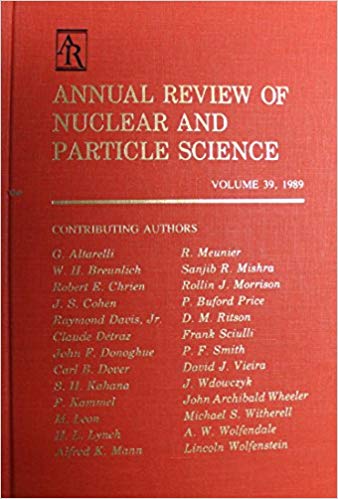New Developments in Flavor Evolution of a Dense Neutrino Gas
IF 8.4
2区 物理与天体物理
Q1 PHYSICS, NUCLEAR
Annual Review of Nuclear and Particle Science
Pub Date : 2020-11-03
DOI:10.1146/annurev-nucl-102920-050505
引用次数: 109
Abstract
Neutrino–neutrino refraction dominates the flavor evolution in core-collapse supernovae, neutron star mergers, and the early Universe. Ordinary neutrino flavor conversions develop on timescales determined by the vacuum oscillation frequency. However, when the neutrino density is large enough, collective flavor conversions may arise because of pairwise neutrino scattering. Pairwise conversions are deemed fast because they are expected to occur on timescales that depend on the neutrino–neutrino interaction energy (i.e., on the neutrino number density) and are regulated by the angular distributions of electron neutrinos and antineutrinos. The enigmatic phenomenon of fast pairwise conversions has been overlooked for a long time. However, because of the fast conversion rate, pairwise conversions could occur in the proximity of the neutrino decoupling region with yet-to-be-understood implications for the hydrodynamics of astrophysical sources and the synthesis of the heavy elements. We review the physics of this fascinating phenomenon and its implications for neutrino-dense sources. Expected final online publication date for the Annual Review of Nuclear and Particle Science, Volume 71 is September 2021. Please see http://www.annualreviews.org/page/journal/pubdates for revised estimates.致密中微子气体风味演化的新进展
中微子-中微子折射主导着核心坍缩超新星、中子星合并和早期宇宙的风味演化。普通中微子风味转换在由真空振荡频率决定的时间尺度上发展。然而,当中微子密度足够大时,由于成对的中微子散射,可能会产生集体风味转换。成对转换被认为是快速的,因为它们预计发生在依赖于中微子-中微子相互作用能(即中微子数密度)的时间尺度上,并由电子中微子和反中微子的角分布调节。长期以来,快速成对转换的神秘现象一直被忽视。然而,由于转换速度快,配对转换可能发生在中微子解耦区附近,这对天体物理源的流体动力学和重元素合成的影响尚未得到理解。我们回顾了这一迷人现象的物理学及其对中微子密集源的影响。预计《核与粒子科学年鉴》71卷的最终在线出版日期为2021年9月。修订后的估计数请参阅http://www.annualreviews.org/page/journal/pubdates。
本文章由计算机程序翻译,如有差异,请以英文原文为准。
求助全文
约1分钟内获得全文
求助全文
来源期刊
CiteScore
21.50
自引率
0.80%
发文量
18
期刊介绍:
The Annual Review of Nuclear and Particle Science is a publication that has been available since 1952. It focuses on various aspects of nuclear and particle science, including both theoretical and experimental developments. The journal covers topics such as nuclear structure, heavy ion interactions, oscillations observed in solar and atmospheric neutrinos, the physics of heavy quarks, the impact of particle and nuclear physics on astroparticle physics, and recent advancements in accelerator design and instrumentation.
One significant recent change in the journal is the conversion of its current volume from gated to open access. This conversion was made possible through Annual Reviews' Subscribe to Open program. As a result, all articles published in the current volume are now freely available to the public under a CC BY license. This change allows for greater accessibility and dissemination of research in the field of nuclear and particle science.

 求助内容:
求助内容: 应助结果提醒方式:
应助结果提醒方式:


